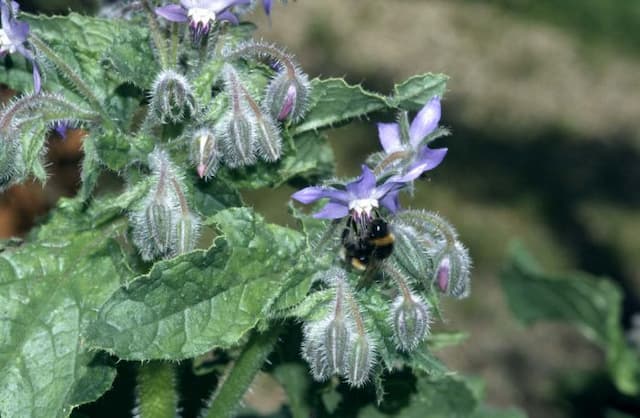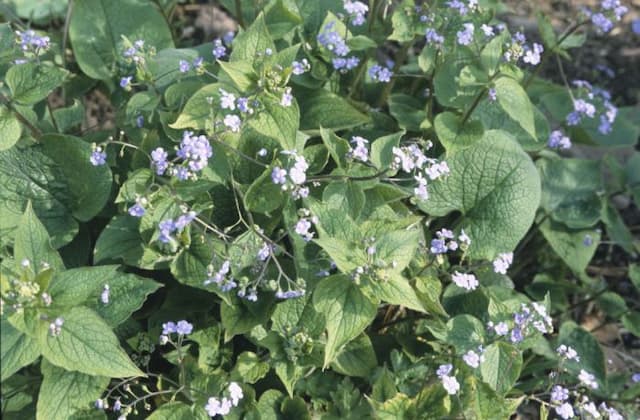Viper's Bugloss Echium vulgare

ABOUT
Echium vulgare, commonly known as viper's bugloss, is a striking and easily recognizable plant with a bold appearance. It features a rosette of narrow, lance-shaped, dark green leaves at its base, from which arises a sturdy flowering stem. These leaves may be rough to the touch with a hairy texture. The plant's most distinctive characteristic is its inflorescence, which is a densely packed, cylindrical spike composed of numerous small flowers. The flowers of viper's bugloss are tubular and consist of five petals that give them a star-like shape. They are extremely eye-catching, usually starting off as a reddish-pink in bud and then maturing into a vivid blue with red stamens, which extend outwards, creating a contrasting and attractive display. Some flowers may present with violet or purplish hues. The blooming stalk is adorned with smaller, narrower leaves compared to the basal rosette. These leaves and stem may also have a rough, hairy surface. The arrangement of the flowers along the stem is such that they seem to spiral around it, creating a sense of movement and depth. The overall look of viper's bugloss is somewhat spiky and bristly, with the multi-hued bloom spike providing a rich source of nectar, making it popular among pollinators like bees. Despite its common name associating it with vipers, it is a plant that adds vibrant color and texture to any setting where it is allowed to thrive.
About this plant
 Names
NamesFamily
Boraginaceae.
Synonyms
Viper's Bugloss, Blueweed, Blue Thistle, Snake Flower, Blue Devil.
Common names
Echium lycopsis, Echium villosum, Echium humile, Echium italicum, Echium pyramidale, Echium violaceum.
 Toxicity
ToxicityTo humans
Viper's bugloss, the common name for Echium vulgare, has components that can be mildly toxic to humans if ingested. Although not typically considered to be severely poisonous, consuming parts of this plant can cause gastrointestinal discomfort, including symptoms like nausea, vomiting, and diarrhea. It is important for people to avoid ingesting parts of the viper's bugloss.
To pets
Viper's bugloss is known to potentially cause toxicity in pets if ingested. The plant contains pyrrolizidine alkaloids, which can be harmful to animals, particularly livestock. If pets consume parts of the viper's bugloss, they may exhibit symptoms such as liver damage, which can lead to signs of lethargy, jaundice, or abnormal behavior. It is advisable to prevent pets from eating this plant to avoid possible negative health consequences.
 Characteristics
CharacteristicsLife cycle
Biennials
Foliage type
Deciduous
Color of leaves
Green
Flower color
Blue
Height
2-3 feet (60-90 cm)
Spread
1-2 feet (30-60 cm)
Plant type
Herb
Hardiness zones
3
Native area
Europe
Benefits
 General Benefits
General Benefits- Attracts pollinators: Echium vulgare, commonly known as Viper's Bugloss, is known to attract bees, butterflies, and other pollinators, enhancing biodiversity.
- Drought-resistant: The plant is tolerant to drought, making it suitable for xeriscaping and low-water gardens.
- Soil stabilization: With its deep root system, it can help prevent soil erosion on slopes and disturbed areas.
- Aesthetic value: Viper's Bugloss adds visual appeal to gardens with its vibrant blue to purplish flowers.
- Wildlife habitat: It provides shelter and food for wildlife, particularly caterpillars of certain moth species.
- Adaptability: It can thrive in a wide range of soil types, from sandy to loamy.
- Low maintenance: Once established, it requires little care, making it a convenient choice for gardeners.
 Medical Properties
Medical Properties- Anti-inflammatory: Echium vulgare has been traditionally used for its anti-inflammatory properties, which can help reduce swelling and pain.
- Antitussive: The plant has been used to alleviate coughs.
- Diuretic: It has properties that can promote the increased passing of urine.
- Emollient: Echium vulgare is known to have skin-softening qualities.
- Expectorant: It may help in the clearance of mucus from the airways.
- Vulnerary: The plant has been used to assist in healing wounds and cuts.
 Air-purifying Qualities
Air-purifying QualitiesThis plant is not specifically known for air purifying qualities.
 Other Uses
Other Uses- Dye Production: Echium vulgare can be used to produce a blue dye from its flowers, which historically was used for coloring fabrics.
- Garden Fertilizer: The plant can be composted and used as a fertilizer in gardens, providing essential nutrients to the soil.
- Wildlife Habitat: Its dense foliage can provide shelter and a breeding habitat for various insects and small animals.
- Floral Arrangements: The striking blue flowers can be used in fresh or dried floral arrangements for decorative purposes.
- Erosion Control: The plant's root system can help in stabilizing soil and preventing erosion on slopes and banks.
- Ink Production: The pigments in Echium vulgare flowers can be used for making natural inks for art or calligraphy.
- Biodegradable Mulch: Dried plant material can serve as a natural, biodegradable mulch to conserve soil moisture and suppress weeds.
- Photography Backdrop: The vivid flowers can create an attractive backdrop for nature photography.
- Pollinator Attraction: The plant is a food source for bees and butterflies, making it ideal for pollinator gardens.
- Fish Poison: Historically, some cultures have used the plant in small quantities to alter water chemistry and temporarily stun fish, making them easier to catch.
Interesting Facts
 Feng Shui
Feng ShuiThe Viper's Bugloss is not used in Feng Shui practice.
 Zodiac Sign Compitability
Zodiac Sign CompitabilityThe Viper's Bugloss is not used in astrology practice.
 Plant Symbolism
Plant Symbolism- Pride: Echium vulgare, commonly known as Viper's Bugloss, often symbolizes pride due to its upright, towering flower spikes that could be seen as representing self-confidence and standing tall.
- Protection: The plant has been associated with protection as it was believed in folk medicine to have the power to ward off viper bites, hence the name "Viper's" Bugloss.
- Deceit: With its snake-like stamens and common name referencing a viper, Viper's Bugloss can also represent deceit or danger, alluding to the snake's symbolism in many cultures.
- Nature's bounty: The abundant flowers and rapid growth of Viper's Bugloss symbolize nature's generosity and the richness of the natural world.
 Water
WaterViper's Bugloss should be watered deeply but infrequently to mimic its natural environment. During the growing season, water the plant every one to two weeks, allowing the soil to dry out between waterings. Typically, applying about one gallon per square yard every couple of weeks should suffice. Reduce watering frequency in the fall and winter when the plant is dormant. It's important not to overwater, as this can lead to root rot.
 Light
LightViper's Bugloss thrives in full sun to partial shade. It prefers a spot that receives at least six hours of direct sunlight daily. The best spot for this plant is in an open area where it can receive ample sunlight without being overshadowed by taller plants, ensuring healthy growth and abundant flowering.
 Temperature
TemperatureViper's Bugloss is hardy and can tolerate a wide range of temperatures. It performs best in temperatures between 60 to 80 degrees Fahrenheit but can survive minimum temperatures down to about 20 degrees Fahrenheit. Avoid exposing the plant to extreme cold below these temperatures for extended periods, as it may not survive.
 Pruning
PruningPruning Viper's Bugloss is generally done to remove spent flower stalks, which encourages new growth and potentially a second bloom. Prune the plant after the first flowering by cutting back the flower spikes to the base. Pruning is typically done in the summer following the bloom period, and if necessary, a light trim can be given in autumn to shape the plant.
 Cleaning
CleaningNot needed
 Soil
SoilViper's Bugloss (Echium vulgare) thrives in well-draining soil with moderate fertility. A mix composed of garden soil, compost, and sand or perlite is ideal. Aim for a pH between 6.0 and 8.0 to ensure the plant's health and flower production.
 Repotting
RepottingViper's Bugloss typically does not need frequent repotting as it is biennial. Repot or transplant young plants if they outgrow their current container or before they establish in the garden.
 Humidity & Misting
Humidity & MistingViper's Bugloss does not require high humidity and is quite adaptable to various conditions. Average room humidity is suitable for this plant, making it quite undemanding in terms of moisture in the air.
 Suitable locations
Suitable locationsIndoor
Ensure full sun, well-draining soil, and infrequent watering.
Outdoor
Plant in full sun, well-draining soil; water occasionally.
Hardiness zone
3-8 USDA
 Life cycle
Life cycleEchium vulgare, commonly known as Viper's Bugloss, begins its life cycle as a seed, which germinates in the spring when soil temperatures and moisture levels are adequate. It develops a rosette of leaves at ground level during its first year, storing energy in preparation for the following year. In its second year, it produces a flowering stem that can grow up to 90 cm tall, with leaves becoming progressively smaller up the stem. The plant blooms from late spring to early autumn, featuring vibrant blue-purple flowers that are highly attractive to pollinators such as bees. After pollination, the flowers develop into fruit capsules containing seeds that are dispersed by wind, animals, or human activity. The plant typically completes its life cycle within two years, dying after seeds have been produced and dispersed, although it can reseed itself and continue its presence in the same area.
 Propogation
PropogationPropogation time
Spring to early summer
Propogation: Echium vulgare, commonly known as Viper's Bugloss or Blueweed, is typically propagated by seed. The best time to sow seeds is either in the fall or early spring. When sowing in the fall, the seeds can be directly scattered onto a prepared garden bed, allowing the winter cold to stratify them naturally; this cold period helps break the seed dormancy and promotes germination in the spring. If planting in spring, it is recommended to stratify the seeds for about 2 to 4 weeks in a refrigerator, equivalent to around 1°C to 4°C, before sowing. The seeds should be lightly covered with soil and, if kept moist, they will usually germinate within two to three weeks. As Viper's Bugloss prefers well-drained soil and full sun, make sure to choose a suitable location that mimics these natural habitat preferences.









